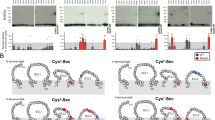Summary
Agonist and antagonist binding characteristics of β-adrenoceptors in turkey erythrocyte ghosts were determined at different temperatures ranging between 7°C and 42°C. [3H]-DHA saturation binding experiments revealed that the antagonist-receptor interaction is entropy-driven with a small enthalpic contribution. Isoproterenol/[3H]-DHA competition binding followed the law of mass action at all the investigated temperatures. The agonist-receptor interaction is enthalpy driven with a small unfavorable decrease in entropy. This is consistent with the agonist's ability to favor an endoenergetic transconformation of the receptors.
Only part of the agonist-bound receptors can undergo functional coupling to the stimulatory component of the adenylate cyclase system (Ns). This coupling process is associated with “locking-in” of the agonist and becomes persistent in the presence of the alkylating reagent N-ethylmaleimide. The number of agonist/N-ethylmaleimide-sensitive sites (i.e. coupling-prone receptors) increases with the temperature until it reaches a plateau value of 50% between 27–32°C. Qualitatively similar data were obtained for rat lung and turkey erythrocyte membranes. These observations suggest that the whole receptor population can undergo agonist-mediated conformational changes but that only part of them can couple to Ns.
Similar content being viewed by others
References
Andre C, Vauquelin G, De Backer J-P, Strosberg AD (1981) Identification and chemical characterization of β-adrenergic receptors in intact turkey erythrocytes. Biochem Pharmacol 30:2787–2795
Arad H, Rosenbusch JP, Levitzki A (1984) Stimulatory GTP regulatory unit Ns and the catalytic unit of adenylate cyclase are tightly associated: mechanistic consequences. Proc Natl Acad Sci USA 81:6579–6583
Brandts JF (1964a) The thermodynamics of protein denaturation. I. The denaturation of chymotrypsinogen. J Am Chem Soc 86:4291–4301
Brandts JF (1964b) The thermodynamics of protein denaturation. II: A model of reversible denaturation and interpretations regarding the stability of chymotrypsinogen. J Am Chem Soc 86:4302–4314
Briggs MM, Lefkowitz RJ (1980) Parallel modulation of catecholamine activation of adenylate cyclase and formation of the high affinity agonist-receptor complex in turkey erythrocyte membranes by temperature and cis-vaccenic acid. Biochemistry 19:4461–4466
Cheng YC, Prusoff WH (1973) Relationship between the inhibition constant (K i) and the concentration of inhibitor which causes 50 percent inhibition (IC50) of an enzymatic reaction. Biochem Pharmacol 22:3099–3108
De Lean A, Stadel JM, Lefkowitz RJ (1980) A ternary complex model explains the agonist-specific binding properties of the adenylate cyclase-coupled β-adrenergic receptor. J Biol Chem 255:7108–7117
Elgsaeter A, Branton D (1974) Intramembrane particle aggregation in erythrocyte ghosts. I. The effect of protein removal. J Cell Biol 63:1018–1030
Franklin TJ (1981) Binding energy and the excitation of hormone receptors. In: Lamble JW (ed) Towards understanding receptors: current reviews in biomedicine, 1. Chapman and Hall, London New York, pp 8–15
Heidenreich KA, Weiland GA, Molinoff PB (1982) Effects of magnesium and N-ethylmaleimide on the binding of 3H-hydroxybenzylisoproterenol to β-adrenergic receptors. J Biol Chem 257:804–810
Henis YI, Rimon G, Felder S (1982) Lateral mobility of phospholipids in turkey erythrocytes. J Biol Chem 257: 1407–1411
IJzerman AP, Bultsma T, Timmerman H, Zaagsma J (1984) The relation between ionization and affinity of β-adrenoceptor ligand. Naunyn-Schmiedeberg's Arch Pharmacol 327:293–298
IJzerman AP, Dorlas R, Aue GHJ, Bultsma T, Timmerman H (1985) Factors controlling β 1-adrenoceptor affinity and selectivity. Biochem Pharmacol (in press)
Insel PA, Sanda M (1979) Temperature-dependent changes in binding to β-adrenergic receptors of intact S49 lymphoma cells. J Biol Chem 254:6555–6559
Korner M, Gilon C, Schramm M (1982) Locking of hormone in the β-adrenergic receptor by attack on a sulfhydryl in an associated component. J Biol Chem 257:3389–3396
Lefkowitz RJ, Stadel JM, Caron MG (1983) Adenylate cyclasecoupled β-adrenergic receptors: structure and mechanisms of activation and desensitization. Ann Rev Biochem 52:159–186
Lowry DH, Rosebrough NJ, Farr AL, Randall RJ (1951) Protein measurement with the Folin phenol reagent. J Biol Chem 193:265–275
Molinoff PB, Weiland GA, Heidenreich KA, Pittman RN, Minneman KP (1981) Interactions of agonists and antagonists with β-adrenergic receptors. In: Dumont JE, Greengard P, Robinson GA (eds) Advances in cyclic nucleotide research. Raven Press, New York, pp 51–67
Nedivi E, Schramm M (1984) The β-adrenergic receptor survives solubilization in deoxycholate while forming a stable association with the agonist. J Biol Chem 259:5803–5808
Orly J, Schramm M (1975) Fatty acids as modulators of membrane functions: catecholamine-activated adenylate cyclase of the turkey erythrocyte. Proc Natl Acad Sci USA 72:3433–3437
Oye I, Sutherland EW (1966) The effect of epinephrine and other agents on adenyl cyclase in the cell membrane of avian erythrocytes. Biochim Biophys Acta 127:347–354
Rimon G, Hanski E, Levitzki A (1980) Temperature dependence of β-receptor, adenosine receptor, and sodium fluoride stimulated adenylate cyclase from turkey erythrocytes. Biochemistry 19:4451–4460
Scatchard G (1949) The attraction of proteins for small molecules and ions. Ann NY Acad Sci 51:660–672
Severne Y, Coppens D, Bottari S, Riviere M, Kram R, Vauquelin G (1984) The influence of the β-adrenergic receptor concentration on their functional coupling to the adenylate cyclase system. Proc Natl Acad Sci USA 81:4637–4641
Severne Y, Wemers C, Vauquelin G (1985) Agonist/N-ethylmaleimide mediated inactivation of β-adrenergic receptors: molecular aspects. Biochem Pharmacol 34:1611–1617
Tanford C (1980) The hydrophobic effect: formation of micelles and biological membranes. J Wiley and Sons, Inc. A Wiley Interscience Publication, New York, pp 21–28
Vauquelin G, Maguire ME (1980) Inactivation of β-adrenergic receptors by N-ethylmaleimide in S49 lymphoma cells: Receptor heterogeneity in relation to coupling to adenylate cyclase. Mol Pharmacol 18:362–369
Vauqueli G, Severne Y, Bottari S, Andre C (1984) Agonist-mediated conformational modification of β-adrenergic receptors. In: Liss AR (ed) Catecholamines: basic and periferal mechanism. New York pp 271–278
Weiland GA, Minneman KP and Molinoff PB (1979) Fundamental difference between the molecular interaction of agonists and antagonists with the β-adrenergic receptor. Nature 281:114–117
Weiland GA, Minneman KP, Molinoff PB (1980) Thermodynamics of agonist and antagonist interactions with mammalian β-adrenergic receptors. Mol Pharmacol 18:341–347
Author information
Authors and Affiliations
Rights and permissions
About this article
Cite this article
Severne, Y., Kanarek, L. & Vauquelin, G. Agonist-mediated conformational changes of β-adrenoceptors could occur independent of functional coupling to Ns. Naunyn-Schmiedeberg's Arch. Pharmacol. 332, 247–252 (1986). https://doi.org/10.1007/BF00504862
Received:
Accepted:
Issue Date:
DOI: https://doi.org/10.1007/BF00504862




